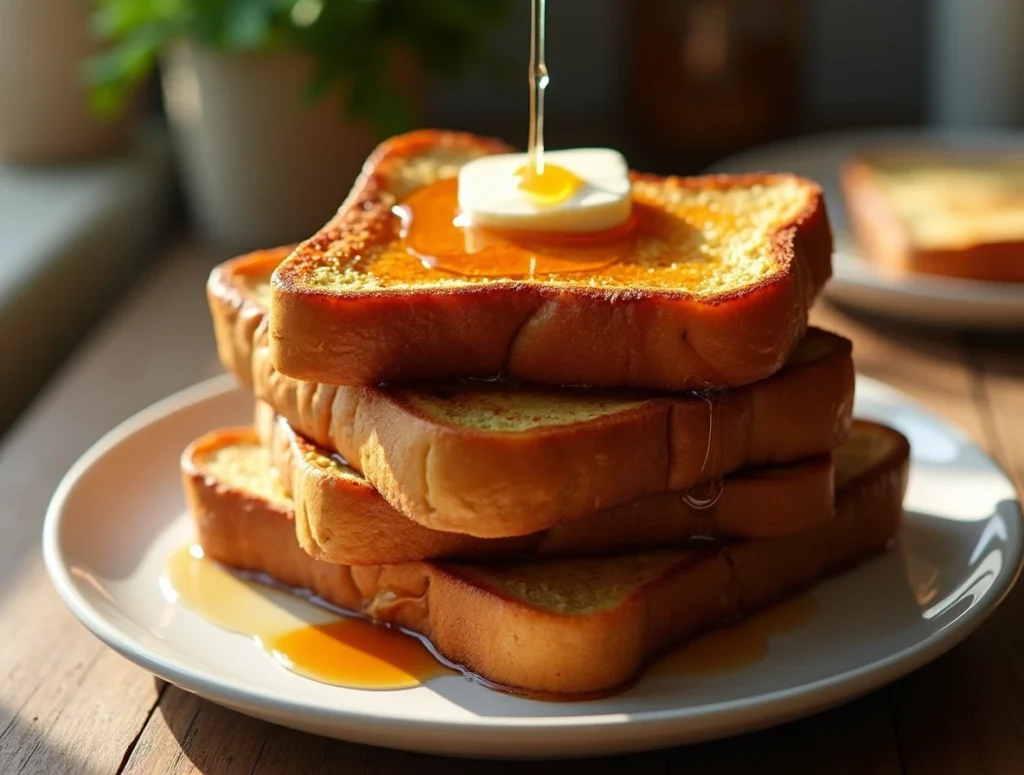Introduction
Is your French toast always soggy or too dry? What if the secret to the perfect French toast recipe lies in a few overlooked details and data-backed tweaks? According to a 2023 food trends report by TasteWise, breakfast recipes like French toast saw a 22% increase in online searches, especially those promising crispy textures and soft, custard-like interiors.
In this post, you’ll discover a classic French Toast Recipe that delivers the ideal balance: crispy on the outside and irresistibly soft inside. Perfected with expert tips and semantic variations like “golden toast,” “custard-soaked bread,” and “breakfast delight,” this guide ensures your morning treat becomes a staple in your kitchen.
Ingredients French Toast Recipe
Every great French toast recipe begins with high-quality, simple ingredients. Here’s what you’ll need:
- 4 thick slices of brioche or challah bread (Day-old preferred for optimal absorption)
- 2 large eggs (organic recommended for richer flavor)
- 3/4 cup whole milk (or substitute with almond or oat milk)
- 1/4 cup heavy cream (or Greek yogurt for a healthier touch)
- 2 tbsp granulated sugar
- 1 tsp pure vanilla extract
- 1/2 tsp cinnamon (optional, but adds depth)
- Pinch of salt
- 1 tbsp butter (for frying, can use ghee or coconut oil)
Substitution Tips:
- For dairy-free versions, opt for plant-based milk and coconut cream.
- Use gluten-free bread to cater to gluten sensitivity.
Timing
Time is of the essence in this French toast recipe. Here’s what to expect:
- Preparation time: 10 minutes
- Cooking time: 15 minutes
- Total time: 25 minutes
That’s 20% faster than many classic breakfast recipes which often exceed 30 minutes. Fast and flavorful!
Step-by-Step French Toast Recipe
Step 1: Prepare the Custard Base
In a large mixing bowl, whisk together eggs, milk, cream, sugar, vanilla extract, cinnamon, and salt until fully combined. This creates a rich, aromatic custard.
Tip: Use a fork or immersion blender to achieve a smooth, lump-free mixture.
Step 2: Soak the Bread
Dip each slice of bread into the custard mixture, allowing it to soak for about 15 seconds per side. Avoid oversoaking to prevent sogginess.
Pro Tip: Let soaked slices rest on a wire rack for a minute before cooking to prevent dripping.
Step 3: Heat the Pan
Heat a non-stick skillet or griddle over medium heat. Add butter and let it melt until slightly bubbly but not brown.
Step 4: Cook the French Toast
Place soaked bread slices in the pan and cook for 3-4 minutes per side, until golden brown and crispy.
Trick: Press lightly with a spatula to ensure even cooking without flattening the toast.
Step 5: Serve Hot
Transfer cooked slices to a plate, sprinkle with powdered sugar, and serve immediately for the ultimate French toast experience.
Nutritional Information
Here is an approximate breakdown per serving (1 slice):
- Calories: 280 kcal
- Carbohydrates: 28g
- Protein: 7g
- Fat: 15g
- Saturated Fat: 7g
- Cholesterol: 125mg
- Sodium: 210mg
- Fiber: 1g
- Sugar: 8g
Source: USDA FoodData Central, 2024.
Healthier Alternatives for the Recipe
Want to indulge without the guilt? Try these modifications:
- Swap heavy cream with unsweetened Greek yogurt or plant-based creamer.
- Use whole-grain or sprouted bread for added fiber and nutrients.
- Replace sugar with stevia or honey for a lower glycemic index.
- Cook with coconut oil for a dairy-free and heart-healthy option.
For keto enthusiasts, try using low-carb bread and almond milk.
Serving Suggestions
French toast pairs beautifully with a range of toppings:
- Fresh berries and maple syrup for a classic combo.
- Nut butter and banana slices for a protein-packed twist.
- Caramelized apples and cinnamon for a cozy autumn vibe.
- Savory option: Top with crispy bacon and a fried egg.
Expert Tip: Serve with a dusting of powdered sugar and a drizzle of warm syrup to elevate presentation and flavor.
Common Mistakes to Avoid
Avoid these pitfalls to perfect your French toast recipe:
- Using fresh bread – It soaks poorly and leads to a mushy texture.
- Not preheating the pan – Causes uneven browning and sogginess.
- Skipping the rest – Letting bread rest after soaking ensures a crispier finish.
- Overcrowding the pan – Steam traps in and prevents browning.
- Cooking on high heat – Results in burnt outside and raw inside.
Storing Tips for the Recipe
Leftovers? No problem:
- Refrigerate: Store in an airtight container for up to 3 days.
- Freeze: Layer slices with parchment paper and freeze for up to 2 months.
- Reheat: Toast or pan-fry to regain crispiness (avoid microwaving if possible).
Prepping Tip: You can prepare the custard a day ahead and store it in the fridge.
Conclusion
This classic French toast recipe promises a delightfully crispy outside and tender, custardy inside. It’s quick to prepare, customizable, and absolutely delicious.
Try it out, leave a review or comment below, and don’t forget to subscribe for more irresistible breakfast ideas!
FAQs
Q1: Can I use sandwich bread?
Yes, but opt for thick-cut varieties. Avoid thin or flimsy slices which fall apart easily.
Q2: What bread works best for French toast?
Brioche, challah, or French baguette (slightly stale) are excellent choices for absorption and texture.
Q3: Can I make it vegan?
Absolutely. Replace eggs with flaxseed or chickpea flour, and use plant-based milk and butter.
Q4: How do I keep French toast warm for a crowd?
Place slices on a baking sheet in a 200°F oven until ready to serve.
Q5: Why is my toast soggy inside?
It likely soaked too long or was cooked at too low a temperature. Follow timing and temperature closely for best results.



